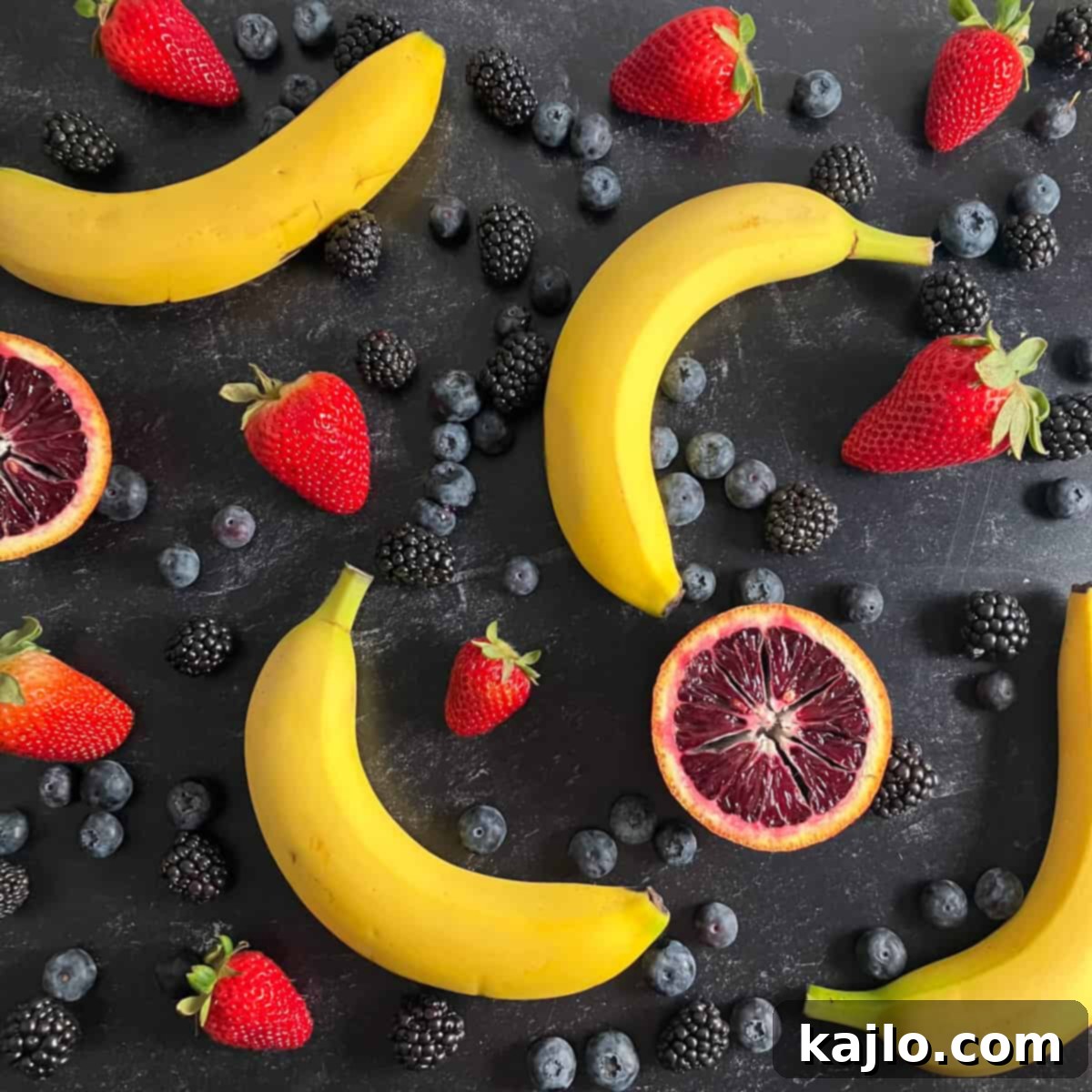Unlock a vibrant world of flavor and nutrition by exploring the fascinating array of fruits that start with B. From familiar favorites found in every grocery store to intriguing exotic varieties, this comprehensive guide is your ultimate reference for B-named fruits. Whether you’re a culinary enthusiast, a health-conscious individual, a student researching a school project, or an educator crafting engaging lesson plans, you’ll find this list both informative and inspiring. Plus, we’ve included a delightful recipe using some of these incredible B-fruits: my delicious Banana Berry Breakfast Bowls!

Curious about which fruits begin with the letter B? We’ll embark on this fruity journey by first highlighting the most common types readily available in many grocery stores, particularly in the U.S. Then, we’ll dive into a selection of more unique and exotic B-fruits from around the globe. Finally, we’ll conclude with a tasty and easy-to-make recipe that celebrates the bounty of B-fruits, providing a perfect way to incorporate them into your daily diet. Get ready to expand your fruit knowledge and tantalize your taste buds!
Common Fruits That Start With B
Let’s start our exploration with fruits beginning with the letter ‘B’ that are frequently found in local markets and are staples in many kitchens. These familiar varieties are not only versatile but also packed with essential nutrients, making them excellent choices for everyday consumption.
1. Banana
Bananas are arguably one of the most beloved and widely consumed fruits that start with B. A true global staple, these crescent-shaped wonders are celebrated for their natural sweetness and creamy texture. Green, unripe bananas are particularly rich in resistant starch, a type of carbohydrate that acts like fiber and can support gut health. As bananas ripen, this resistant starch converts into simple sugars, making them a fantastic natural sweetener for smoothies, oatmeal, yogurt bowls, and various baked goods.
The vast majority of bananas found in US supermarkets belong to the Cavendish cultivar, which dominates the commercial banana industry. This monoculture raises concerns about the global banana supply, as a single disease outbreak could potentially devastate the entire crop. Despite these challenges, bananas remain an incredibly convenient and nutritious fruit, providing potassium, vitamin B6, and vitamin C. They are perfect for a quick snack, an energy boost before a workout, or as a delightful addition to countless recipes.
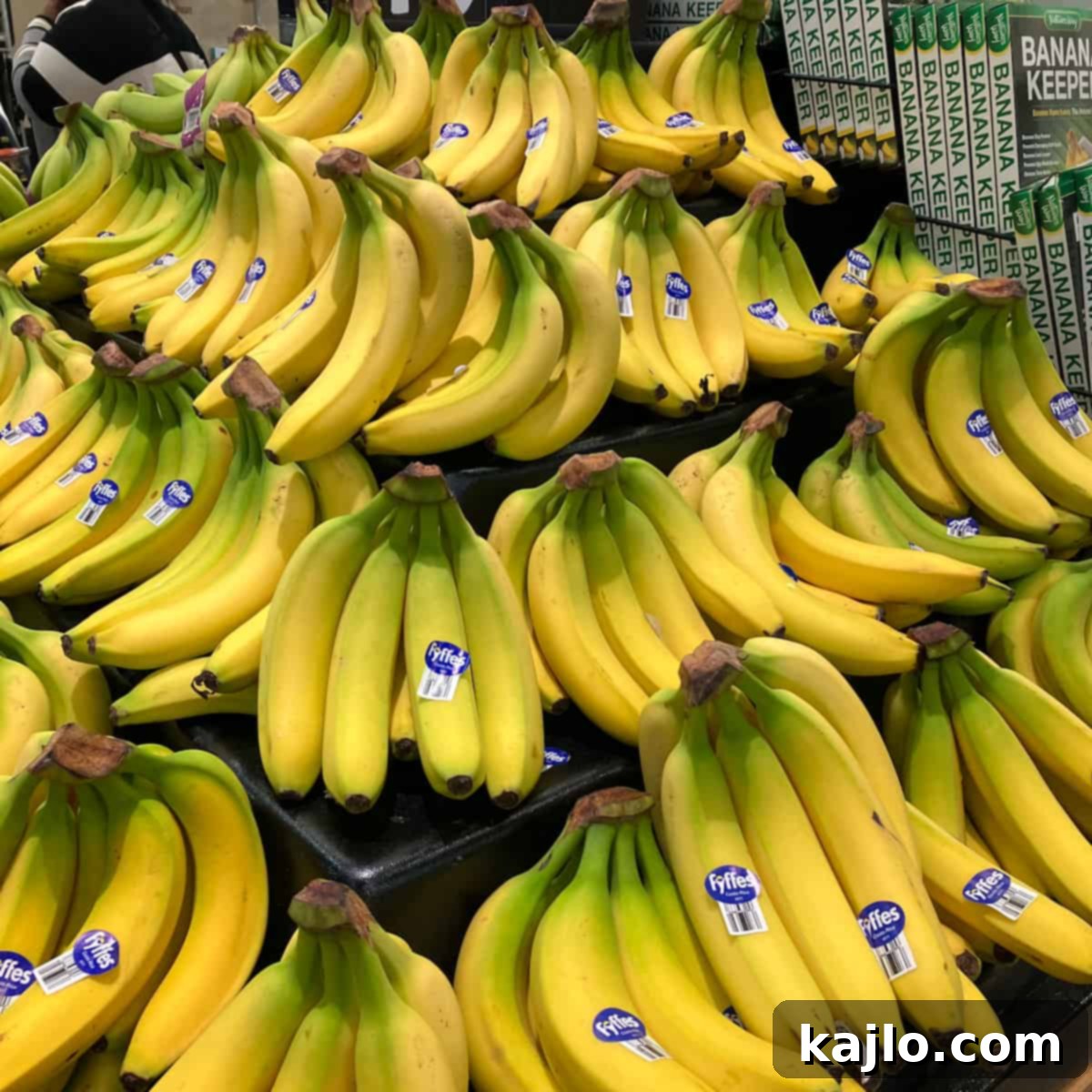
2. Bell Pepper
While often categorized as vegetables in culinary contexts and dietary guidelines like MyPlate, bell peppers are botanically fruits. They develop from the flower’s ovary and contain seeds, fitting the scientific definition of a fruit. Therefore, they rightfully earn a spot on our list of fruits that start with B.
Bell peppers come in a vibrant spectrum of colors—red, yellow, orange, and green—each offering a slightly different flavor profile. They are incredibly versatile, lending a crisp texture and mild sweetness to dishes when raw, or a tender, rich flavor when cooked. Bell peppers are an excellent source of vitamin C, even surpassing oranges in some varieties, and are low in carbohydrates, making them suitable for keto-friendly diets. Enjoy them sliced in salads, stir-fries, fajitas, or roasted for a sweeter, more intense flavor.
3. Berries
The term “berries” encompasses a broad and diverse group of small, pulpy, and often edible fruits, many of which proudly feature on our list of B-fruits. This collective category is a favorite for many, offering an explosion of flavors, vibrant colors, and a wealth of health benefits. While true berries, in botanical terms, include fruits like bananas and grapes, the culinary definition is more commonly understood. Common examples include strawberries, raspberries, and marionberries, alongside the prominent blackberries and blueberries, which we will discuss in more detail below.
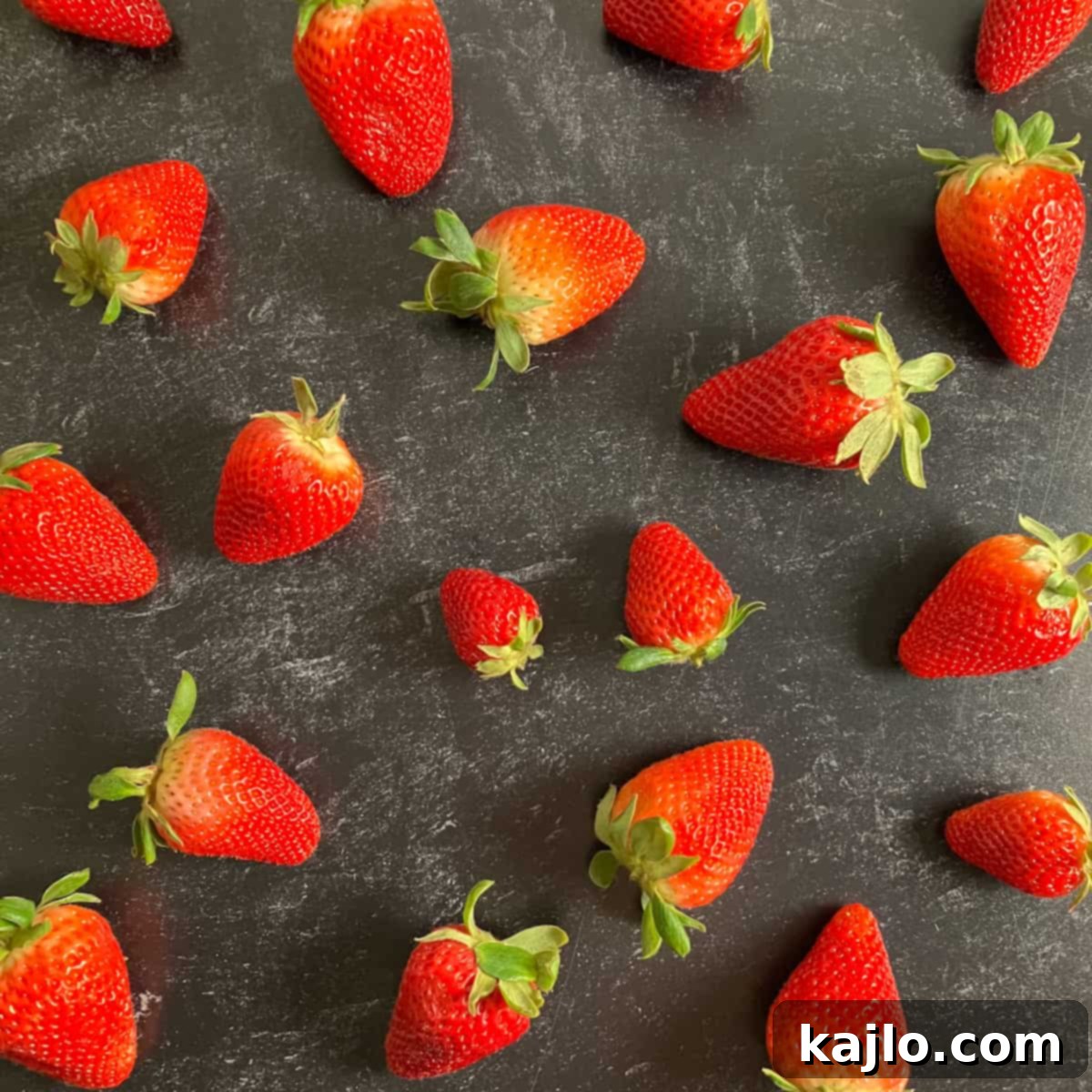
Beyond the well-known varieties, you might encounter lesser-known gems at farmers’ markets or specialty stores. Golden berries, also known as Cape gooseberries, are a prime example—a sweet-tart fruit native to South America. And, perhaps surprisingly, you’ve likely enjoyed the Chinese gooseberry, better known worldwide as the kiwi fruit. Berries, in all their forms, are celebrated for being rich in antioxidants, vitamins, and fiber, making them a fantastic addition to any diet.
4. Blackberry
Juicy, dark, and wonderfully tart-sweet, fresh blackberries are a delightful addition to the berry family and a standout among fruits starting with B. These seedy fruits are exceptionally rich in dietary fiber, vitamin C, and vitamin K, contributing significantly to digestive health and immunity. Their distinctive deep purple-black hue comes from powerful phytochemicals called anthocyanins, which are potent antioxidants associated with various health benefits.
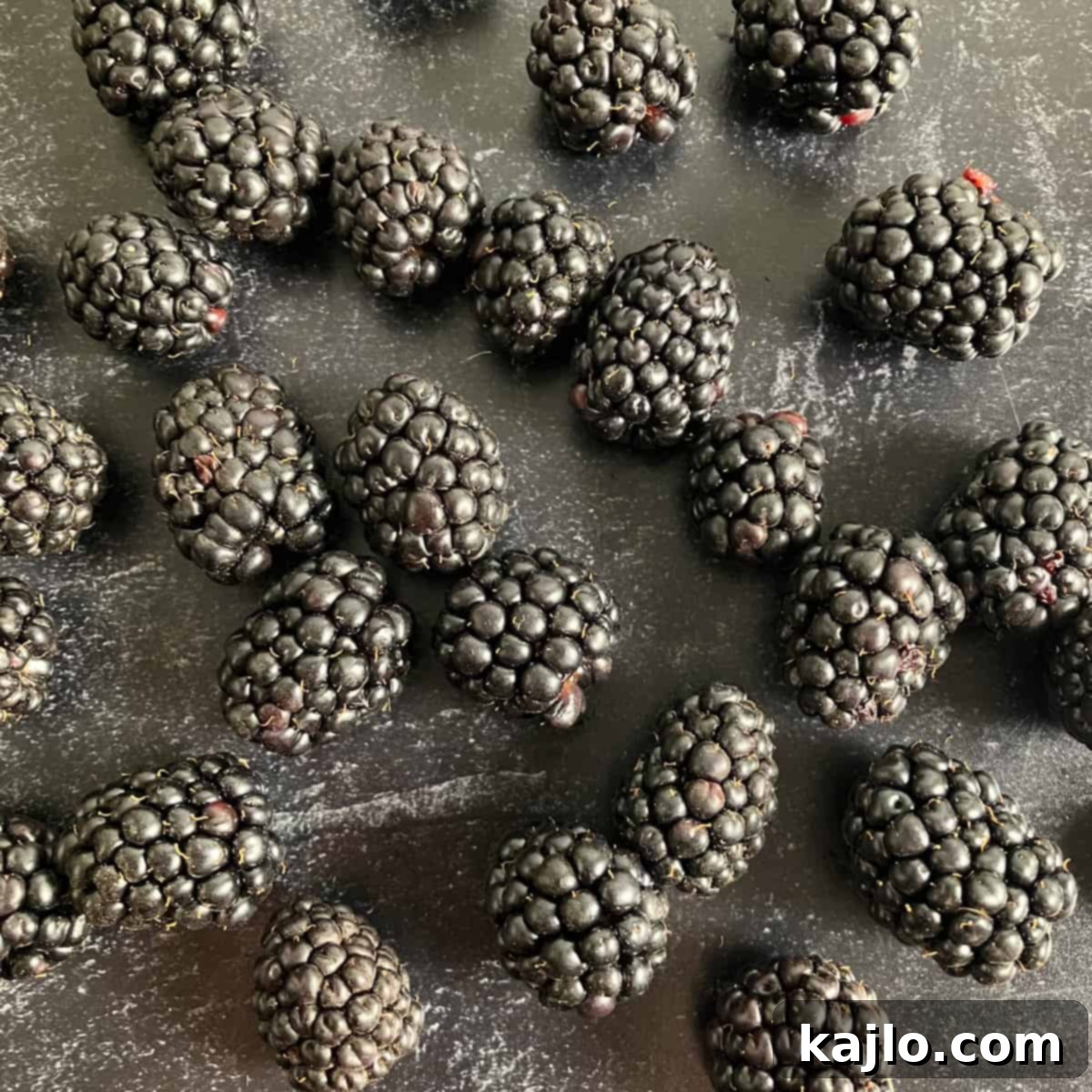
Blackberries shine in a multitude of culinary applications. They are perfect for baking into muffins, pies, crumbles, and crisps, where their tartness provides a lovely contrast to sweet pastry. They also make exquisite jams and jellies. For a simple and healthy treat, enjoy them fresh on their own or mixed into yogurt. You can certainly incorporate these delightful berries into the Banana Berry Breakfast Bowl recipe provided later in this article, adding a burst of flavor and nutrition.
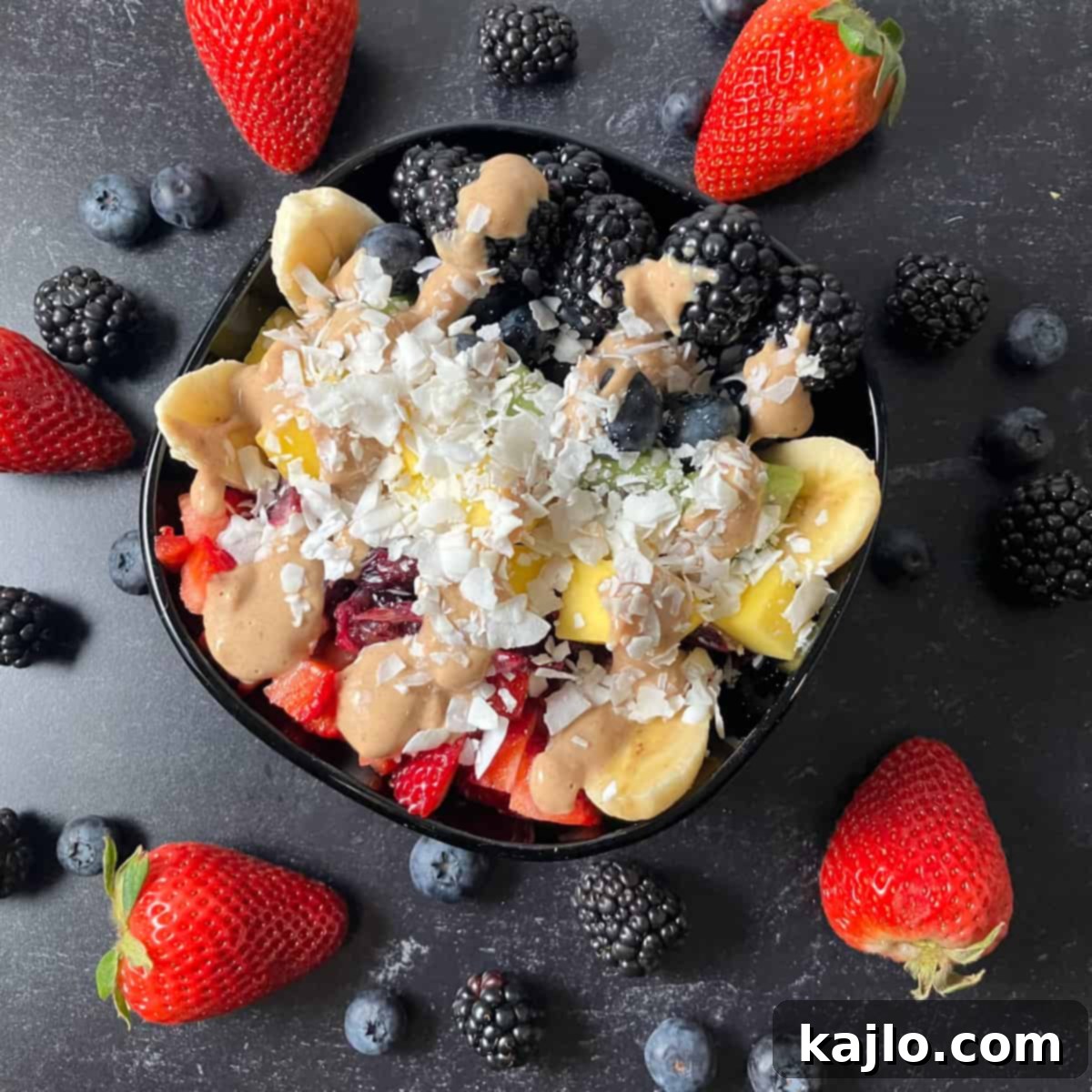
5. Black Grapes
Black grapes, with their rich, deep color and sweet flavor, are another excellent example of B fruits. While they are most famously cultivated for winemaking, these succulent fruits are equally delightful for fresh snacking. Similar to blackberries, the intense dark coloration of black grapes is attributed to the presence of anthocyanins, powerful antioxidant pigments.
Though not among the lowest-carb fruits, black grapes are low in calories and have a high fluid content, making them a hydrating and satisfying choice. Depending on your location and the season, they can also be one of the more economical fruit options available. Consider adding a handful of these delicious grapes to your next fruit salad for a burst of sweetness and a beautiful visual appeal. Their delicate skin and juicy interior make them a refreshing treat any time of day.
6. Black Raisin
Black raisins are simply the dried version of black grapes, making them a concentrated source of sweetness and nutrients. These are the familiar raisins you’ll typically find in popular brands and childhood lunchboxes. Their dark appearance distinguishes them from sultanas or golden raisins, which are derived from dried green grapes. Drying grapes concentrates their natural sugars, making raisins a naturally sweet and energy-dense snack.
For an economical and versatile dried fruit option, black raisins are a top choice. They are incredibly adaptable in the kitchen, from savory dishes like chicken salad and couscous to sweet treats such as trail mix, oatmeal raisin cookies, and bread puddings. Their chewy texture and intense sweetness can satisfy a sugar craving while providing a good source of fiber and minerals. Always keep a bag on hand for an instant flavor boost to many recipes.
7. Black Raspberry
Black raspberries offer a taste profile similar to their more common red counterparts but possess a distinct appearance, resembling smaller, rounder blackberries. Finding fresh black raspberries in conventional stores can sometimes be a challenge, as they have a shorter shelf life and are less widely cultivated for fresh market sale. However, they are often available in processed forms, with black raspberry ice cream being a particularly popular product that showcases their unique flavor.
Like other berries, black raspberries are especially rich in dietary fiber, making them an excellent choice for supporting digestive health and increasing fiber intake, particularly for those who may not consume many whole grains. They are also packed with antioxidants and vitamins. If you come across fresh black raspberries at a specialty market or pick-your-own farm, savor their unique sweet-tart flavor, or look for them in preserves and desserts.
8. Blood Orange Fruit
The blood orange is a striking citrus fruit that stands apart from typical oranges due to its uniquely colored flesh and juice, which range from deep crimson to a vivid red-purple. This dramatic pigmentation is a result of anthocyanins, the same powerful polyphenol pigments found in blackberries and black grapes. Some enthusiasts describe the flavor of a blood orange as a delightful blend, hinting at notes of strawberry or raspberry alongside its characteristic citrusy tang.
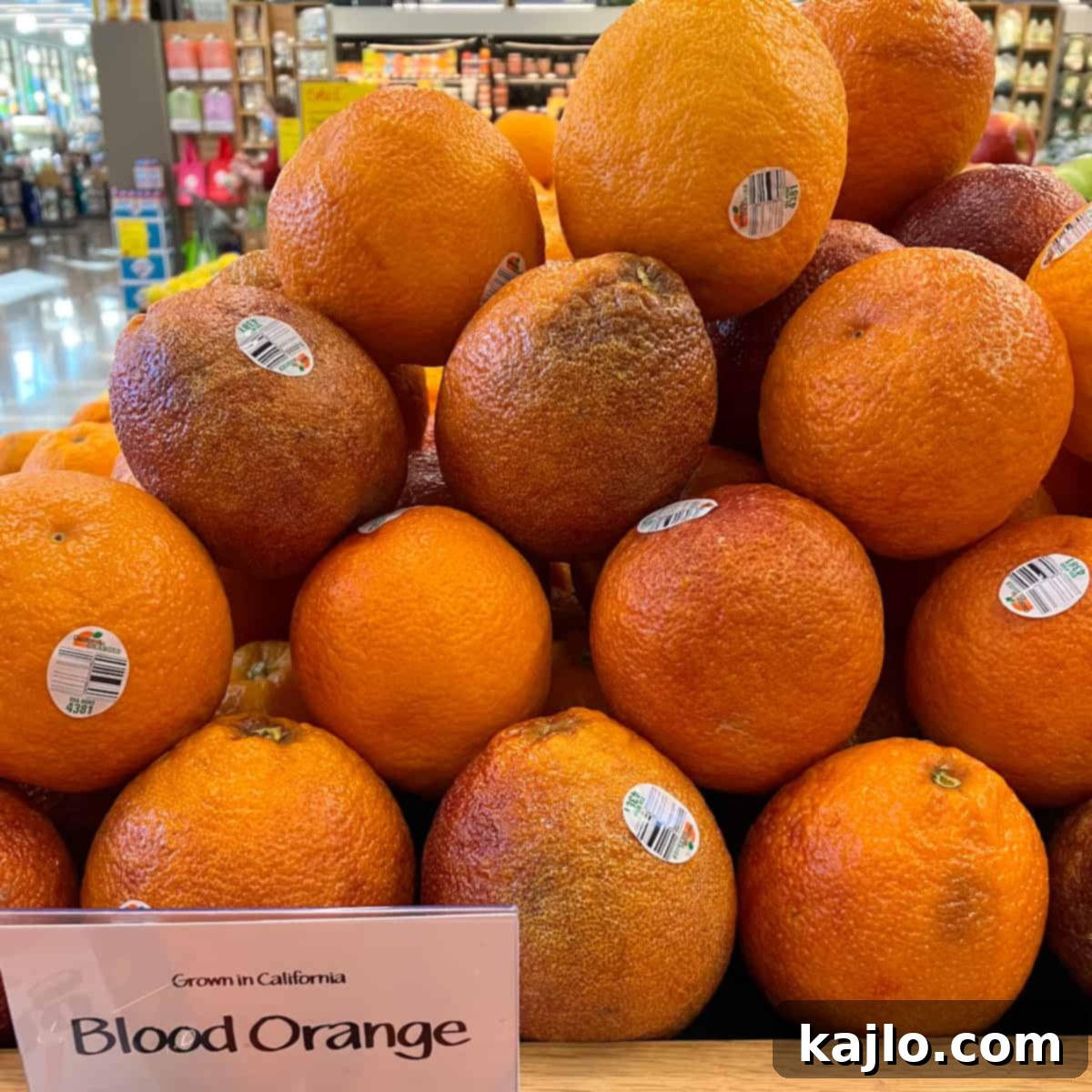
If you’re eager to try blood oranges, they are typically easiest to find in grocery stores during the late winter and spring months, when they are in season. They make a beautiful and flavorful addition to salads, cocktails, desserts, or simply enjoyed fresh on their own. Their stunning color can elevate any dish, making them both a culinary and visual treat.
9. Blueberry
Blueberries are a consistently popular choice among fruits that begin with B, known for their sweet flavor and ease of availability. These small, round berries are one of the most accessible members of the berry family, often found fresh or frozen in stores year-round. Their versatility in the kitchen is unmatched; they are a staple in blueberry muffins, a refreshing addition to smoothies, a bright component in salads, and perfect for various desserts and breakfast dishes.
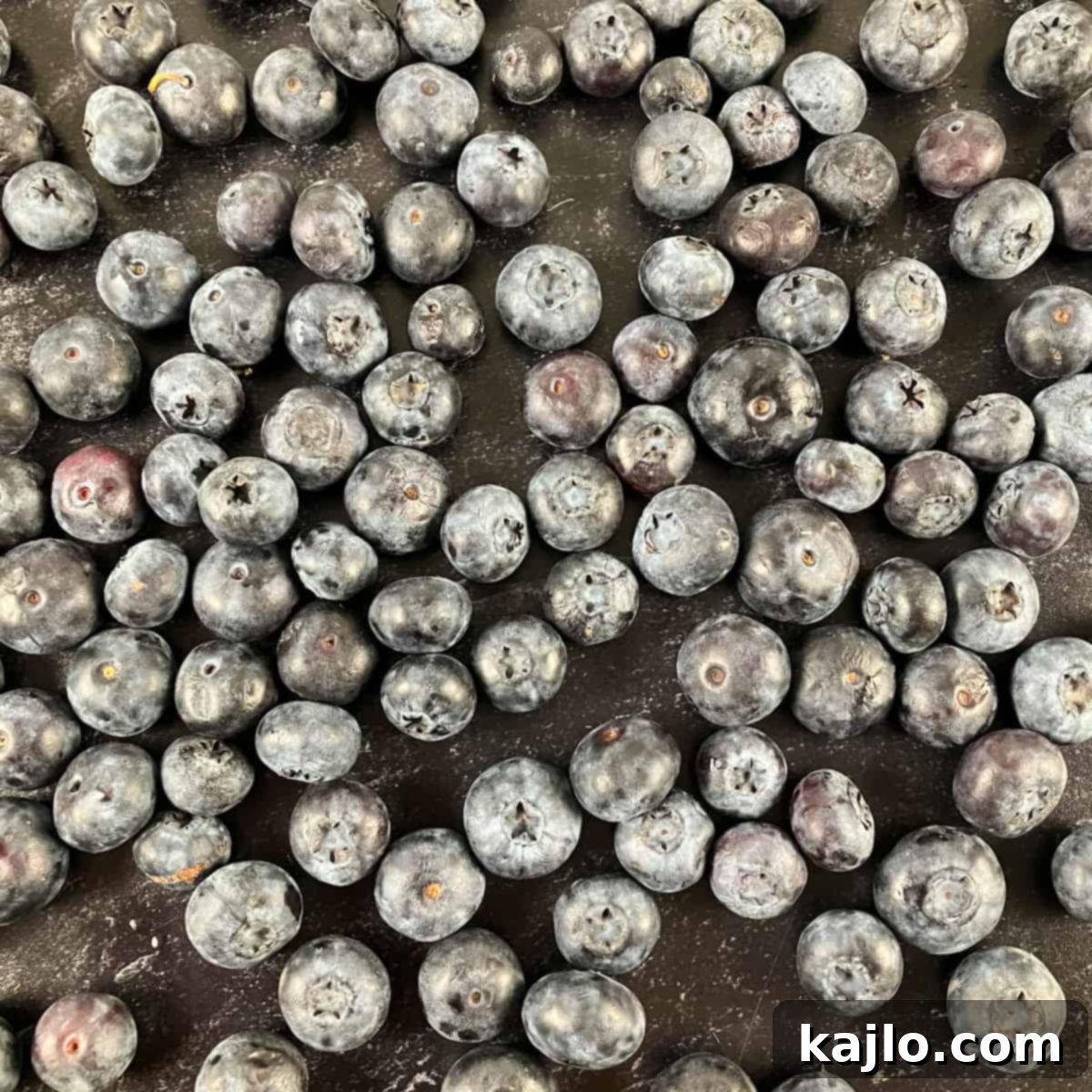
One notable advantage of fresh blueberries is their superior shelf life compared to other delicate berries like raspberries, often lasting several days longer in the refrigerator. This characteristic makes them a preferred choice for meal prepping and for dishes like overnight oats, where their freshness can be enjoyed over a longer period. Beyond their convenience, blueberries are nutritional powerhouses, rich in antioxidants, fiber, and vitamin C, making them an excellent choice for overall health and well-being.
10. Boysenberry
The boysenberry is a fascinating hybrid berry, created from a cross between raspberries, blackberries, loganberries, and American dewberries. This complex parentage results in a large, deep purple fruit with a unique sweet-tart flavor that many find irresistible. However, boysenberries are notoriously fragile, which makes them challenging to transport and limits their availability as fresh produce in most stores.
If you wish to experience the distinctive taste of boysenberries, your best chance is often through pre-made products. Look for them in artisanal jams, jellies, pies, ice cream, and other baked goods, where their concentrated flavor can truly shine. These processed forms allow you to enjoy the boysenberry’s unique profile even if fresh berries are elusive. Their rich flavor profile makes them a prized ingredient in specific culinary applications.
11. Bramble Fruit
According to UMass Extension, the term “bramble fruit” refers to a broad grouping of over 200 species of fruits within the genus *Rubus*, which notably includes familiar favorites like blackberries and raspberries. These fruits grow on thorny bushes or canes, which are characteristic of bramble plants. Most types of bramble fruits are edible, though the degree of thorniness on the plants can vary significantly among species.
Bramble fruits are widely appreciated for their diverse flavors and nutritional benefits. They are often foraged in the wild or cultivated for commercial use. Beyond their culinary appeal, many bramble species are important for local ecosystems, providing food for wildlife. Exploring the world of bramble fruits can reveal a surprising variety of textures and tastes, each contributing to the rich tapestry of edible berries.
Exotic Fruits That Start With B
Now, let’s venture into the more uncommon and intriguing fruits that start with B, many of which you might not find in your local supermarket but are worth seeking out for their unique flavors, textures, and cultural significance.
12. Babaco Fruit
Hailing from the high-altitude regions of Ecuador, the babaco fruit is a fascinating natural hybrid of two types of mountain papaya, *Vasconcellea cundinamarcensis* and *Vasconcellea stipulata*. It is primarily cultivated for its refreshing edible fruit and for making delicious fruit juice. The babaco shares a resemblance to papaya but is generally smaller, more elongated, and often features five distinct ridges, giving it a star-like cross-section.
A significant advantage of babaco is its entirely edible skin and the complete absence of seeds, making preparation effortless. Its flavor profile is a complex and delightful mix, often described as a combination of papaya, strawberry, pineapple, and kiwi. This unique blend of tropical flavors makes babaco an excellent choice for fresh consumption, fruit salads, smoothies, or exotic juices, offering a taste experience unlike any other.
13. Bacuri Fruit
The bacuri fruit, also known by its botanical name *Platonia insignis*, is a tropical gem native to the Amazon rainforest. This fruit bears some resemblance to a papaya in shape and size but boasts a distinct sweet and sour taste that is highly prized in its native regions. The rich pulp of the bacuri fruit is succulent and aromatic, with a creamy texture.
Bacuri is incredibly versatile in culinary applications. It is widely used in beverages, adding a unique tang to juices and cocktails. Its creamy pulp is also perfect for making luxurious ice creams, sorbets, and various condiments. Nutritionally, bacuri fruit is a notable source of vitamin C, an essential antioxidant, and non-heme iron, contributing to overall health. Its unique flavor and nutritional benefits make it a cherished component of Amazonian cuisine.
14. Bael Fruit
According to Purdue Horticulture, bael fruit (*Aegle marmelos*) goes by many names, including Bengal quince, Indian quince, golden apple, holy fruit, and stone apple, reflecting its diverse cultural significance. While it is an edible fruit, bael is perhaps more widely recognized for its extensive applications in traditional medicine, particularly in Ayurveda, rather than solely as a culinary ingredient. Its hard woody shell gives it the “stone apple” moniker.
Despite its medicinal fame, bael fruit does hold a place in local cuisines. In Indonesia, the flesh of the bael fruit is sometimes enjoyed with palm sugar for breakfast, offering a sweet and nourishing start to the day. In India, it is famously combined with milk and sugar to create a popular and refreshing drink called sherbet. Unripe bael fruit can also be used to make flavorful jams and preserves, harnessing its unique aromatic qualities. Its complex flavor is often described as sweet, astringent, and slightly spicy.
15. Balsam Apple
The balsam apple, scientifically named *Momordica balsamina*, is a striking tropical vine plant characterized by its bright orange, warty fruits that split open when ripe to reveal red seeds. Historically, as noted by the Monticello website, the balsam apple was valued for its medicinal properties in Europe during the mid to late 1500s, where it was traditionally used to treat wounds.
In some parts of Africa, the young leaves and unripe fruits of the balsam apple are cooked and consumed much like a vegetable, appreciated for their nutritional value. However, it is crucial to note that ripe balsam apple fruit can be poisonous and may cause gastrointestinal disturbances if ingested, according to sources like NCSU Plants. Therefore, care must be taken regarding its ripeness and preparation. This dual nature of being both a food source and a medicinal plant, with potential toxicity, makes the balsam apple a unique and interesting fruit on our list.
16. Banganapalle Mango
The Banganapalle mango is a highly esteemed variety of mango specifically cultivated in certain regions of India, renowned for its superior taste and quality. This particular mango boasts sweet, juicy yellow flesh and is highly regarded for its suitability in canning processes, allowing its delightful flavor to be preserved. Like all mangoes, the Banganapalle variety is an excellent source of provitamin A, crucial for vision and immune function, and vitamin C, a powerful antioxidant.
In the U.S., consumers are more likely to find common mango types such as Tommy Atkins, Kent, Keitt, Haden, Francis, and Honey mango (also known as Champagne mango or Ataulfo mango), as per Wikipedia. While you might not easily find Banganapalle mangoes outside of specialized markets, any type of ripe mango can be a fantastic addition to various dishes. Feel free to use your locally available mangoes in the recipe below, ensuring you still get that sweet, tropical flavor and nutritional boost.
17. Baobab Fruit
The baobab fruit, an egg-shaped treasure from Africa, grows on the majestic baobab trees, often called the “Tree of Life” due to their remarkable longevity and the resources they provide. These grand trees, known for their white flowers, can take up to 200 years to produce fruit, and some may never fruit at all, making the baobab fruit a truly precious commodity, as highlighted by Specialty Produce.
Inside its hard shell, the baobab fruit contains a unique tangy, powdery pulp and dark, edible kernels. This pulp is often touted as a “superfood,” a marketing term that, while appealing, can be superfluous. However, it’s undeniable that baobab is exceptionally rich in a wide array of vitamins and minerals, including vitamin C, calcium, magnesium, and potassium. While these nutrients are abundant, they can also be found in many other accessible foods, negating the need for specialized baobab supplements. The fruit’s distinct tart flavor makes it popular in drinks, porridges, and as a natural thickener.
18. Barbadine
*Passiflora quadrangularis* is the scientific name for the plant known as “barbadine” in Trinidad, but it might be more familiar to some by its Haitian name, grenadine, or simply giant granadilla. This tropical vine produces large, oblong fruits with a tough, greenish-yellow skin and a sweet, aromatic pulp.
The barbadine fruit is highly valued for its fragrant and succulent pulp, which is commonly used to make refreshing drinks, such as punches and juices, and is a popular ingredient in ice cream and sorbets. In some regions, like parts of Sri Lanka, barbadine fruit is even cooked and prepared like a curry, demonstrating its versatility in both sweet and savory applications. Its distinctive tropical aroma and flavor make it a unique addition to any culinary exploration.
19. Barbados Cherry
In the United States, the Barbados cherry is most frequently recognized and referred to as “acerola cherry.” This small, bright red fruit is celebrated for an extraordinary nutritional quality: it is one of the richest natural sources of vitamin C on the planet, often containing significantly more than an orange. Its tart and slightly sweet flavor makes it a refreshing treat.
Due to its high vitamin C content, acerola cherry powders and supplements are widely available in pharmacies and online, marketed for immune support. While these products can be convenient, a more economical and holistic approach to boosting vitamin C intake is to simply consume locally available fruits and vegetables that are naturally rich in this essential nutrient. Enjoying fresh Barbados cherries when available provides a delicious way to get a powerful antioxidant boost.
20. Barberry
Barberries, also known as zereshk, are small, tart red berries that play a significant role in Persian cuisine, where their bright, tangy flavor is highly valued. While fresh barberries are typically hard to find in US stores due to import regulations and limited cultivation, their dried form is quite popular and can be purchased online. Their vibrant color and distinct sourness make them a unique ingredient.
Dried barberries can serve as an excellent substitute for dried cranberries, dried tart cherries, or even raisins in recipes, depending on the desired flavor profile. Their sharp acidity adds a fantastic counterpoint to richer dishes, especially in rice pilafs, stews, and poultry preparations common in Iranian cooking. If you are a foodie who enjoys exploring international flavors, I highly recommend adding dried barberries to your pantry; they truly elevate many dishes and bring an authentic taste to Persian-inspired meals.
21. Batuan
Batuan (*Garcinia morella*), a fruit primarily used in Filipino cuisine, provides a distinctive sour flavor that is essential to many traditional dishes. Unlike many commercially farmed fruits, batuan is typically grown in the wild, which makes it a rare find in conventional grocery stores outside of its native regions.
For those seeking to incorporate its unique tang into their cooking, you might be able to find batuan fruit paste in specialty stores that focus on ingredients from the Philippines. If fresh or pasteurized batuan is unavailable, tamarind paste can serve as a suitable substitute to achieve a similar sour flavor profile in your recipes. Batuan is prized for its ability to cut through rich, fatty dishes, adding brightness and complexity to stews and soups.
22. Bayberry
Bayberries encompass a range of fruits from different species, presenting a variety of colors from white to red and dark purple, each offering a delightful balance of sweet and tart flavors. These berries typically feature a juicy pulp that can easily stain your lips and fingers, a testament to their rich pigment. The taste profile and appearance can vary significantly depending on the specific species, such as *Myrica rubra* (yangmei) or *Myrica pensylvanica* (wax myrtle).
While often enjoyed fresh in regions where they grow, bayberries, particularly the Asian varieties, have a very short shelf life. This fragility means they are usually not found in stores outside of Southeast Asia. To preserve their flavor and extend their use, bayberries are commonly transformed into juice or wine. Additionally, they can be canned, dried, or pickled, offering various methods to enjoy this delicious and versatile fruit throughout the year.
23. Beach Plum
Beach plums (*Prunus maritima*) are resilient small fruits that thrive along the sandy dunes of the northeast coast of the United States and southern Canada. These charming plums typically have a dark purple skin and a flavor profile that can vary widely, ranging from intensely tart to pleasantly sweet, depending on specific growing conditions, sun exposure, and other environmental factors.
A characteristic feature of beach plums is their relatively high pit-to-flesh ratio, and it is important to note that the pits should not be consumed. This often makes preparation a bit more labor-intensive, but using a cherry pitter can significantly ease the process, especially when making beach plum jam or jelly, which are popular uses for this fruit. Their unique coastal flavor makes them a prized local ingredient for preserves and desserts.
24. Bearberry
Bearberry, also known as kinnikinnick (*Arctostaphylos uva-ursi*), is a low-growing evergreen plant found across vast regions of North America, Europe, and Asia. It is commonly utilized as a ground cover due to its hardy nature and attractive foliage. The plant produces bright red berries that are a favorite food source for bears, hence its common name, as detailed by NCSU Plants.
While the fruit of the bearberry plant is technically edible for humans, it is rarely consumed. Many people find the taste to be undesirable, often described as bland or slightly astringent, and the texture of the berries is typically mealy rather than juicy or succulent. Therefore, while bears might enjoy them, bearberries are generally not sought after for human culinary purposes, making them a more significant fruit for wildlife than for our tables.
25. Beechnut Tree Fruit
For many in the U.S., the name “Beech-Nut” is synonymous with a well-known brand of baby food. However, beyond the commercial product, there are actual beechnut trees (*Fagus* genus) that produce edible fruits. These fruits are small, encased in a prickly bur, and resemble tiny nuts when mature.
The fruits of the beech tree are generally described as bitter or astringent when raw, though they can be quite nutritious. Historically, beechnuts were a significant food source for both humans and wildlife. In past times, the leaves of the beech tree were even roasted and ground to create a substitute for coffee. While not a common supermarket item today, beechnuts represent an interesting piece of arboreal edibles, especially for those interested in foraging or historical food practices.
26. Betel Nut
The betel nut, also known as areca nut, is an important distinction on our list: it is technically the seed of the areca palm fruit, not the fruit itself. Across various cultural groups, particularly in parts of Asia, the betel nut is chewed as a stimulant drug, often combined with betel leaf and slaked lime. It serves a purpose more akin to tobacco than a culinary ingredient used for its nutritional value or flavor, as noted by the ADF.
It is crucial to be aware that the use of betel nut carries significant health risks, including a higher risk of mouth, throat, and stomach cancers, as well as oral submucous fibrosis. Additionally, it can cause damage to teeth and lead to severe black staining, according to Health Vermont. Given these serious health concerns, it is strongly recommended to steer clear of betel nut consumption for any purpose.
27. Bilberry
The bilberry, often interchangeably referred to as huckleberry in North America, is a small, dark fruit that closely resembles a blueberry. This native berry holds a special place, being recognized as the state fruit of Idaho, reflecting its abundance and cultural significance in the region. Bilberries typically grow in mountainous and forested areas, thriving in cooler climates.
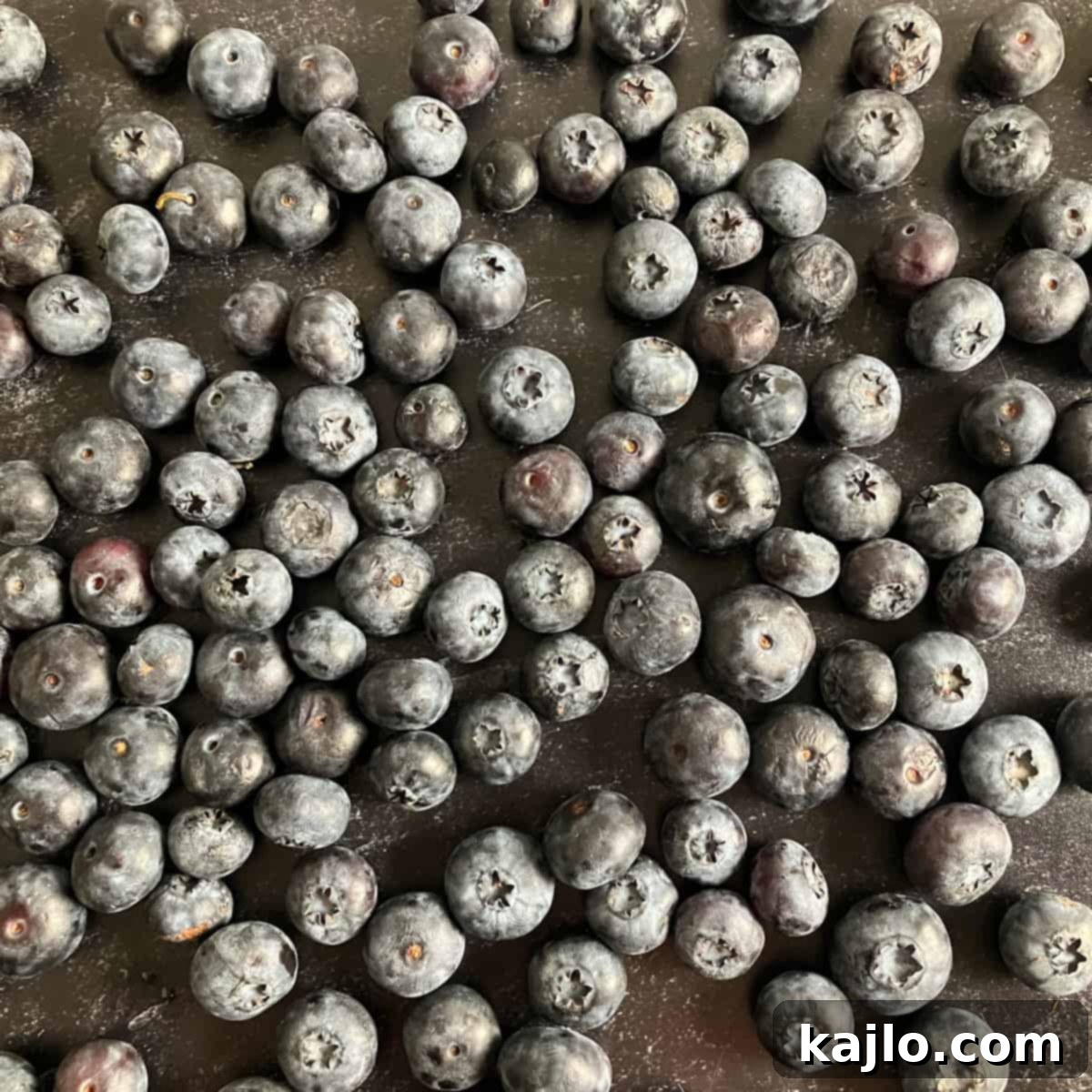
While fresh bilberries might be challenging to find outside of their growing regions, their distinctive sweet-tart flavor is often preserved in various products. If you wish to experience their unique taste, you can frequently purchase bilberry jam or syrup online. These products capture the essence of the fruit, allowing you to enjoy their rich flavor in desserts, on toast, or mixed into yogurt. Bilberries are also known for their high antioxidant content, similar to blueberries.
28. Bilimbi
The bilimbi plant (*Averrhoa bilimbi*) is known by several evocative names, including “tree sorrel” and “cucumber tree,” reflecting its tart flavor and often elongated, cucumber-like appearance. The fruit undergoes a color transformation as it ripens, transitioning from a vibrant green to a pale white. Inside, the flesh of the bilimbi is typically green, gelatinous, and notably acidic, which is its defining characteristic.
Due to its intense acidity, bilimbi fruit is generally considered too sour to be eaten raw on its own. However, its tartness is highly prized in various culinary traditions. In some cultures, the fresh fruit is processed into relishes, chutneys, and savory sauces, adding a bright, piquant note to dishes. It is also used to prepare refreshing drinks that are similar to lemonade, offering a zesty, tangy beverage, as noted by Purdue Horticulture. Bilimbi’s sharp flavor makes it an excellent ingredient for balancing rich flavors in cuisine.
29. Biriba
Biriba, also known as Rollinia fruit (*Rollinia deliciosa*), is an exotic tropical fruit belonging to the same botanical family (Annonaceae) as two more familiar custard fruits: cherimoya and soursop. This relationship hints at its creamy, luxurious texture. Many describe the edible biriba fruit as having a flavor remarkably similar to lemon meringue pie, offering a delightful combination of sweet and tangy notes.
The flesh of the biriba is a striking bright white, possessing a unique creamy, jelly-like consistency that is incredibly smooth and melts in the mouth. Biriba is typically enjoyed fresh, often simply scooped out of its spiky, golden-yellow skin. Beyond fresh consumption, its luscious pulp can be incorporated into a variety of culinary creations, including jams, smoothies, and other desserts and baked goods, lending a distinctly tropical and indulgent flavor to any treat.
30. Bitter Gourd
Bitter gourd, or bitter melon (*Momordica charantia*), is a fruit that unequivocally lives up to its name, thanks to its extremely bitter flavor. Its distinctive appearance, resembling a spiky, elongated cucumber, makes it easily recognizable. I have personally found bitter gourd at markets specializing in East Asian foods, where it is a popular and respected ingredient.
For those unaccustomed to strong bitter tastes, bitter gourd can definitely be an acquired taste, and trying it raw is not recommended for sensitive palates. To mellow out some of its intense bitterness, it is common practice to soak the fruit in water, often with salt, and then cook it. Even after these preparations, its flavor remains very strong and unique, acting as a powerful counterpoint in many Asian dishes, particularly stir-fries, soups, and curries, where it is valued for its medicinal properties and ability to add complexity to a meal.
31. Black Apple
The term “black apple” most commonly refers to the unique Black Diamond apple, an unusual and visually striking fruit originating from Tibet. These apples are distinguished by their remarkably dark, almost iridescent purple-black skin, which gives them their distinctive name. Despite their dark exterior, the flesh of the Black Diamond apple is white, much like other common apple varieties, offering a crisp and sweet experience.
Unfortunately, Black Diamond apples are extremely rare and unlikely to be found by consumers living in the United States or most Western countries, as they are primarily grown and consumed in specific regions of Tibet. However, depending on your location within the U.S., you might encounter Arkansas Black apples, which offer a slightly lighter but still deep red-purple skin. These can serve as a suitable, richly colored substitute for the elusive Black Diamond apple, perfect for adding a touch of drama to a Halloween-themed party or any fairytale-inspired gathering.
32. Black Cherry
While Rainier and Bing cherries are common varieties in many regions, the world of cherries extends far beyond these familiar types. Among the lesser-known but equally delightful varieties is the black cherry, which also goes by names such as rum cherry or mountain black cherry (*Prunus serotina*). These cherries typically have a darker skin and offer a distinct flavor profile that differentiates them from their sweeter, red counterparts.
Black cherries are incredibly versatile and can be readily used as a substitute for other types of cherries in a wide range of recipes. Their rich, deep flavor makes them excellent for crafting jams, adding depth to pies, tarts, and other baked goods. Beyond sweet applications, black cherries can also provide a unique dimension to savory recipes, particularly those involving game meats or rich sauces, where their tartness can cut through richness and add complexity. They are a fantastic addition to any chef’s repertoire.
33. Black Currant
Fresh black currants (*Ribes nigrum*) are a delightful but often elusive fruit in the United States. Historically, their cultivation and importation were restricted or outright illegal in many parts of the U.S. until relatively recently, primarily due to concerns about their role in spreading white pine blister rust, a disease harmful to the timber industry. This history explains why raisins are often used in American recipes as a stand-in for dried currants.
However, black currants are widely celebrated and utilized in international recipes, particularly in the UK and European cuisines, where they are prized for their intense tartness and rich, deep flavor. They are used in everything from jams, jellies, and cordials (like cassis) to pies and sauces. Fortunately, despite their scarcity in fresh form, you can now readily buy dried black currants on Amazon, allowing you to incorporate their unique, tangy taste into your culinary adventures, adding a European touch to your dishes.
34. Black Mulberry
Black mulberries (*Morus nigra*) are visually similar to blackberries but often stand out due to their slightly larger size and more oval shape, offering a distinctive appearance. These juicy, sweet-tart fruits are a delightful seasonal treat and are highly versatile in the kitchen. Their flavor profile closely mirrors that of blackberries, making them an excellent and often interchangeable substitute in many recipes.
Black mulberries truly shine when transformed into various preserves and desserts. They are exceptionally delicious in homemade jellies, vibrant sorbets, rich pies, and other baked goods, where their natural sweetness and slight tartness create a wonderful balance. Enjoy them fresh from the tree, in a refreshing fruit salad, or capture their seasonal flavor in cooked dishes. They are also known for their rich antioxidant content, adding a health boost to their delicious taste.
35. Black Sapote
The black sapote (*Diospyros nigra*) is one of the most intriguing and uniquely named fruits that start with B, often affectionately called “chocolate pudding fruit” due to its uncanny resemblance to the dessert. This tropical fruit is botanically related to the persimmon, sharing some similarities in texture when ripe. On the outside, black sapote typically has a green or brown skin, which can be unassuming, but its interior reveals a dark brown to black flesh with a remarkably smooth, custard-like texture.
When perfectly ripe, the black sapote can be enjoyed simply on its own, its natural sweetness and creamy consistency making for a truly unique eating experience. It is also a fantastic ingredient for culinary creativity. It blends beautifully into smoothies, creating a naturally rich and subtly sweet base. Moreover, it can be used to make healthier “chocolate” spreads and puddings, offering a guilt-free indulgence that mimics the flavor and texture of traditional chocolate desserts without added sugars or fats.
36. Blood Lime
While many are familiar with blood oranges, a lesser-known but equally captivating citrus hybrid is the blood lime (*Citrus australasica x Citrus sinensis*). This Australian-developed citrus fruit is a fascinating cross between the Ellendale Mandarin hybrid and red finger limes, resulting in a distinct flavor and appearance. It is primarily available in Australia, where it was first cultivated.
Blood limes are typically smaller than standard limes and generally offer a sweeter, less intensely acidic flavor profile, with a delicate balance of sweet and tart notes. Their interior flesh is a beautiful red-orange, while the edible skin can range from dark red to green, adding to their unique aesthetic appeal. These limes can be used in any application where you would typically use a standard lime, adding a vibrant splash of color and a subtly sweeter, more complex citrus flavor to dishes, drinks, and desserts.
37. Blue Tongue Fruit
The blue tongue fruit (*Melastoma malabathricum*) grows on a bushy plant primarily found in Australia and parts of Southeast Asia. As its whimsical name implies, consuming this sweet, blue-black fruit has a rather playful side effect: it can temporarily stain your mouth and tongue a deep blue color! This characteristic makes it a fun and memorable fruit to try.
The fruit itself is typically small, round, and develops a deep blue-black hue when ripe. Its flavor is generally described as sweet and pleasant, making it appealing for fresh consumption. Beyond being a curiosity, blue tongue fruit is also part of local culinary traditions and is sometimes used in jams or as a natural dye. Its unique staining property and sweet taste make it a charming, if uncommon, addition to the world of B fruits.
38. Bolwarra
Bolwarra (*Eupomatia laurina*), also known as native guava, is an indigenous Australian fruit appreciated for its unique flavor and versatility. This edible fruit features a creamy, aromatic flesh that is dotted with many small, edible seeds, similar to a fig or kiwi. Its flavor is often described as a delicate blend of apple, cinnamon, and eucalyptus, offering a distinctly Australian taste profile.
Bolwarra can be enjoyed in a multitude of ways. It is delicious eaten raw, providing a refreshing and aromatic snack. Its complex flavor also makes it an excellent ingredient for culinary creations; it can be used to make fragrant jams, sauces, and desserts. Additionally, for preservation and later use in recipes, bolwarra fruit can be dried, allowing its unique flavor to be enjoyed long after its harvest season. It’s a true bush tucker delight.
39. Boquila Berries
Boquila berries are the fruit of the *Boquila trifoliolata* plant, a remarkable vine native to the temperate rainforests of Chile and Argentina. This plant is scientifically fascinating for its unique ability to mimic the leaves of other plants it climbs upon, a rare trait known as mimetic polymorphism. As the Boquila vine twists around its host trees, it later produces small, edible berries.
The berries themselves are generally small, dark, and are consumed by local wildlife and, occasionally, humans. While not widely cultivated or commercially available, they are part of the local ecosystem’s food chain. Their presence highlights the rich biodiversity of their native habitat and offers another example of a lesser-known fruit beginning with ‘B’ that plays a role in its natural environment.
40. Bottle Gourd
Bottle gourd (*Lagenaria siceraria*), also known as calabash, long melon, or birdhouse gourd, is another prime example of a botanical fruit often treated as a vegetable in the kitchen. This versatile plant produces fruits that can be harvested at different stages of maturity for distinct uses. When harvested young, bottle gourds resemble a light-colored zucchini or cucumber and are cooked and prepared like a tender vegetable.
If allowed to mature and dry, these gourds develop a hard, woody shell and are traditionally used as containers, utensils, or even birdhouses, showcasing their practical utility beyond food. You can sometimes find fresh bottle gourds in stores that specialize in East Asian produce, where they are a common ingredient in soups, stir-fries, and stews. Their mild flavor and soft texture make them an adaptable addition to many savory dishes.
41. Brazilian Guava Fruit
The Brazilian guava fruit (*Psidium guineense*) refers to small, vibrant yellow fruits that grow on a shrub native to Brazil and other parts of South America. These charming fruits typically feature a white or yellowish flesh that, when ripe, possesses a consistency often likened to that of a banana, offering a smooth and tender texture. Their flavor is distinctly sweet and tropical, sometimes with subtle tart undertones, making them incredibly refreshing.
Brazilian guavas are not only delicious but also nutritionally rich, particularly in antioxidants such as vitamin C and vitamin A, which are vital for immune health and vision. They are a popular ingredient in Brazil, famously used in a beloved national dessert called goiabada, a sweet, dense guava paste often served with cheese. Beyond this, they are enjoyed fresh, in juices, jams, and other sweets, celebrating their tropical essence.
42. Breadfruit
Breadfruit (*Artocarpus altilis*), often called Ulu in Polynesian cultures, is a substantial and culturally significant fruit, roughly the size of a football. Its skin coloration ranges from green to yellow-brown, indicative of its ripeness. The interior flesh of the breadfruit starts pale yellow-white and becomes softer and starchier as it ripens.
When cooked, the flavor of breadfruit is frequently compared to that of a potato, offering a mild, starchy base. However, it also carries a subtle aroma reminiscent of freshly baked bread, which gives the fruit its evocative name. Breadfruit is incredibly versatile in culinary applications, being roasted, boiled, fried, or baked in various savory dishes. It serves as a staple food in many tropical regions, providing significant nutritional value. Keep an eye out for breadfruit when visiting local markets specializing in international foods; encountering it fresh is a culinary treat well worth seeking out to experience its unique texture and mild, comforting flavor.
43. Broadleaf Bramble Fruit
The broadleaf bramble (*Rubus moluccanus*), also known as Molucca bramble, is a thorny shrub native to Australia and parts of Southeast Asia. This robust plant produces edible berries that are quite similar in appearance and texture to other members of the *Rubus* genus, such as raspberries and blackberries. The fruits are typically red to purple-black when ripe and are a welcome addition to the list of B fruits.
Broadleaf bramble berries can be enjoyed fresh directly from the bush, offering a pleasant sweet-tart flavor. Their versatility also extends to culinary applications, where they are excellent for making sauces, adding a tangy kick to various dishes, or transforming into delicious jams and jellies, perfect for preserving their seasonal goodness. Nutritionally, these berries are particularly high in vitamin C, contributing to immune health and overall well-being. They represent another wild, edible gem from the diverse bramble family.
44. Buddha’s Hand
Buddha’s hand (*Citrus medica var. sarcodactylis*), also known as fingered citron, is an extraordinary citrus fruit with one of the most unusual and striking appearances in the plant kingdom. Instead of a round or oval shape, it looks like a burst of yellow tendrils or a collection of finger-like projections, hence its common names. I first encountered this fascinating fruit in the exotic fruits section of a local grocery store, immediately captivated by its unique form.
What truly sets Buddha’s hand apart from other citrus fruits is its composition: it contains no juice or edible flesh, consisting almost entirely of zest and pith. This makes it a culinary ingredient focused solely on its highly fragrant rind. You can finely grate Buddha’s hand zest and use it in any recipe that calls for citrus zest, imparting an incredibly aromatic and floral fragrance to desserts, savory dishes, and cocktails. It can also be candied, much like lemon peel, creating a gourmet sweet treat. Its intense aroma and unique form make it a chef’s delight and a captivating conversation piece.
45. Burdekin Plum
The Burdekin plum (*Pleiogynium timorense*) is an indigenous Australian fruit that, externally, resembles a regular plum in shape and color, typically dark purple. However, a key distinguishing feature is its unusually large and fibrous pit, which accounts for a significant portion of the fruit’s volume. These plums have a unique ripening process; they generally do not ripen fully while still on the tree.
To achieve optimal ripeness, Burdekin plums are best picked when firm and then kept in a paper bag for approximately seven days, allowing them to soften and develop their full flavor. This Australian fruit is remarkably versatile and can be enjoyed in a variety of ways. It is excellent fresh, offering a sweet-tart taste, and can be incorporated into salads, savory sauces, and jams. Furthermore, its natural sugars and distinct flavor make it suitable for winemaking, showcasing its diverse culinary potential.
46. Burmese Grape
The Burmese grape (*Baccaurea ramiflora*), also known as rambai or mafai, is a delicious and highly regarded fruit that grows on a handsome evergreen tree native to Southeast Asia. The fruits typically grow in dense clusters directly on the tree trunk and branches, presenting a striking visual. Their taste is often described as similar to lychee, offering a sweet, juicy, and slightly acidic flavor with a translucent, segmented pulp.
Burmese grapes are highly versatile and enjoyed in several ways. They are delicious when consumed fresh, offering a refreshing and aromatic snack. The fruit can also be fermented into wine, producing a distinctive local beverage. Additionally, Burmese grapes are often stewed, either on their own or with other ingredients, to create sweet or savory dishes, demonstrating their adaptability in various culinary applications across the region.
47. Bush Cherry
The bush cherry (*Prunus besseyi*), also known as Western Sand Cherry, is a hardy and resilient fruit-bearing plant native to the central and western parts of North America. It produces small, dark red cherries that are distinctly sour. These crisp, tart, and tangy fruits offer a refreshing burst of flavor that is highly prized for culinary uses, particularly where a sharp acidity is desired.
Beyond its edible fruits, the bush cherry plant is also valued for its ornamental qualities. Many gardeners choose to cultivate it in their landscapes because of its abundant and beautiful white flowers that bloom in spring, followed by attractive foliage in the fall. While the fresh fruit might be too tart for some to eat raw in large quantities, bush cherries are excellent for making jams, jellies, pies, and sauces, providing a vibrant, piquant flavor that brightens any dish.
48. Button Mangosteen
The button mangosteen (*Garcinia prainiana*) is a lesser-known but delightful fruit from a tree native to Thailand and Malaysia, regions renowned for their rich diversity of tropical fruits. This fruit is often overshadowed by its more famous relative, the common mangosteen (*Garcinia mangostana*), but it holds its own with unique characteristics.
The button mangosteen is distinguished by its relatively thin skin and a flavor profile that many describe as similar to a tangerine, offering a pleasant balance of sweet and tangy notes. Its flesh is juicy and refreshing, making it an enjoyable fruit for fresh consumption. While not as widely exported as other tropical fruits, it is a cherished local delicacy, adding to the rich tapestry of Asian fruit varieties. Its accessibility in its native lands makes it a welcome treat for locals.
***
This extensive list provides a deep dive into fruits that start with B, but it’s important to remember that the botanical world is vast and ever-surprising. There are undoubtedly many other B-fruits out there, some still undiscovered or highly localized. A crucial note: always exercise caution when encountering unfamiliar fruits in the wild. Some fruits not mentioned on this list may be toxic to humans, so always verify edibility before consumption.
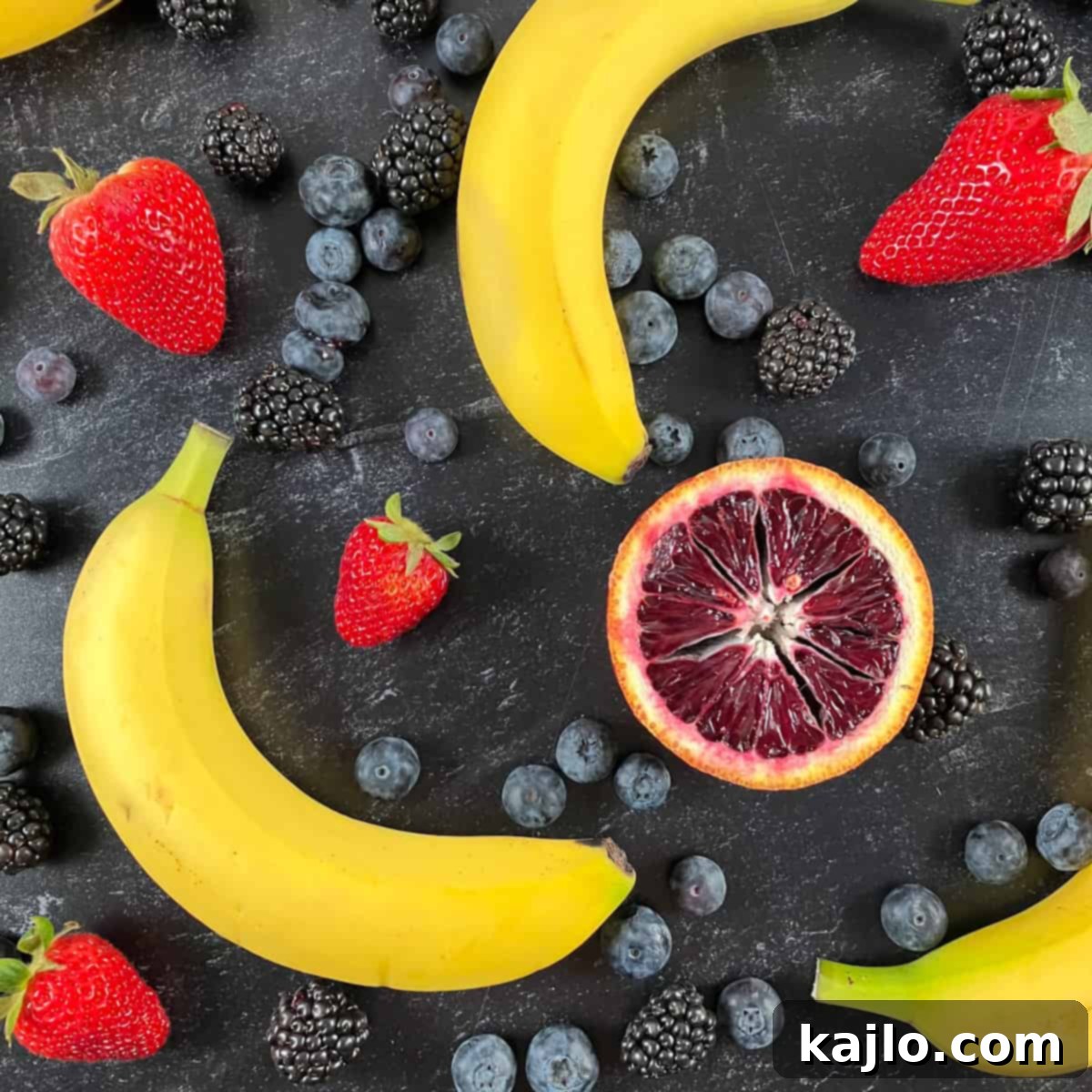
FAQs for Fruits That Start With B
What is the longest fruit name beginning with B on this list?
Based on our comprehensive list, the Broadleaf Bramble Fruit holds the distinction of having the longest name among fruits that start with B.
What are some vegetables that start with B?
While our focus is on fruits, it’s fun to expand the B-word culinary world! Some notable vegetables beginning with B include: bamboo shoots, various types of beans, bean sprouts, beets, broccoli, broccolini, bok choy, Brussels sprouts, and butternut squash. Now you’re well-equipped to name a fruit or veg beginning with B!
👩🏻🍳 Other Recipes with Fruit
If you’re looking for more delicious ways to enjoy fruit, explore these other fantastic recipes:
- Overnight Oats with Frozen Fruit
- Strawberry Banana Mango Smoothie with Milk
- Peach and Pineapple Salsa
Watch How to Make It!
Enjoy a visual guide to making this recipe!

Banana Berry Breakfast Bowls
Summer Yule
Pin Recipe
10 mins
10 mins
Breakfast
American
1
454 kcal
Ingredients
- 1 medium banana, split lengthwise
- ¾ cup plain, unsweetened Greek yogurt (non-fat; use sweetened yogurt if preferred)
- ¼ cup strawberries, diced (¼-½ inch pieces; about 2 berries)
- ¼ cup blood orange, peeled and chopped
- ¼ cup mango, peeled and chopped (¼-½ inch pieces, any variety works well)
- 1 kiwi, peeled and chopped (¼-½ inch pieces)
- 3 tablespoons blueberries
- ¼ cup blackberries (about 5 berries)
- 1 tablespoon creamy peanut butter
- 1 tablespoon water
- 1 tablespoon unsweetened coconut, toasted
Instructions
- Place the split banana halves into a serving bowl. Evenly top them with the Greek yogurt.
- Artfully arrange all of the prepared fruits on top of the banana and yogurt. (Make sure you’re using a bowl large enough to hold all the deliciousness!)
- In a small separate bowl, whisk together the water and creamy peanut butter until smooth. You can adjust the amount of water to achieve your desired drizzling consistency.
- Drizzle the peanut butter mixture generously over the fruit toppings. Finish by sprinkling with the toasted coconut.
- Take a moment to admire the beautiful and nutritious breakfast bowl you’ve created, featuring an abundance of fruits that start with B! Enjoy every spoonful.
Equipment
- Knife
- Peeler
Notes
💭 Expert Tips from Dietitian Summer Yule
This is a level 1 recipe (may help support fat loss). Fruits are an excellent way to incorporate filling fluid volume and fiber into your meals with minimal calories. They are hydrating, naturally sweet, utterly delicious, and perfectly suited for enjoyment at any time of the day.
Moreover, fruits that start with B, along with other fruit varieties, provide a diverse assortment of essential vitamins and minerals. These include vital nutrients like vitamin C, provitamin A, potassium, and beneficial phytonutrients such as anthocyanidins and carotenoids, all contributing to your overall health and well-being.
A common characteristic of most fruits is their low protein and healthy fat content. When building a meal around fruit, remember to complement it with foods rich in these macronutrients. In this recipe, we’ve thoughtfully added protein-packed Greek yogurt and creamy peanut butter to provide healthy fats, creating a balanced and satisfying meal.
If you have picky eaters at home, fruits are often more readily accepted than vegetables. Kids especially adore this fun and colorful presentation of a classic fruit and yogurt parfait, making it a fantastic and enjoyable way to eat a rainbow of nutrients.
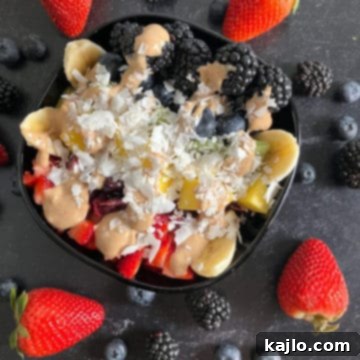
Nutrition information is for one serving.
nutrition info disclaimer
All recipes on this website may or may not be appropriate for you, depending on your medical needs and personal preferences. Consult with a registered dietitian or your physician if you need help determining the dietary pattern that may be best for you.
The nutrition information is an estimate provided as a courtesy. It will differ depending on the specific brands and ingredients that you use. Calorie information on food labels may be inaccurate, so please don’t sweat the numbers too much.
“To taste” means to your preferences, which may have to be visual to follow food safety rules. Please don’t eat undercooked food x
Nutrition
Carbohydrates: 73.8g
Protein: 22.9g
Fat: 12.2g
Saturated Fat: 3.7g
Sodium: 123.9mg
Potassium: 1082.4mg
Fiber: 12.4g
Vitamin A: 35% DV
Vitamin C: 194.9% DV
Calcium: 53.7% DV
Iron: 2.8% DV
b fruit, b fruits, fruits b, fruits starting with b, fruits that begin with b, fruits that begin with the letter b, fruits that start with b
What are your personal favorite fruits that start with B? Do you know of any fascinating B-fruits that we might have missed on our extensive list? We’d love to hear from you! Please share your thoughts, recommendations, and any unique B-fruit discoveries in the comments section below. Your input helps us continue to explore and appreciate the incredible diversity of the fruit world!

Join our community! Subscribe for all of the latest and greatest recipes, and follow me on Facebook, Pinterest, Instagram, and YouTube!
